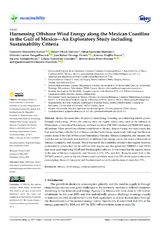Harnessing Offshore Wind Energy along the Mexican Coastline in the Gulf of Mexico—An Exploratory Study including Sustainability Criteria
Autor
Hernández Galvez, Geovanni
Chuck Liévano, Daniel
Sarracino Martínez, Omar
Lastres Danguillecourt, Orlando
Dorrego Portela, Rafael
Trujillo Narcía, Antonio
Saldaña Flores, Ricardo
Pampillón González, Liliana
Perea Moreno, Alberto Jesús
Hernandez-Escobedo, Quetzalcoatl
Editor
MDPIFecha
2022Materia
Wind energyOffshore
Sustainability
Mexico
METS:
Mostrar el registro METSPREMIS:
Mostrar el registro PREMISMetadatos
Mostrar el registro completo del ítemResumen
Mexico has more than 40 years of researching, investing, and obtaining electric power through wind energy. Within the country, there are highly windy areas, such as the Isthmus of Tehuantepec or the state of Tamaulipas, and there are about 2500 MW installed and 70,000 MW tested, all onshore. There are still no offshore wind farms in Mexico, despite having two main coasts, the East and the West, with the Gulf of Mexico and the Pacific Ocean, respectively. Although the Mexican coastal states of the Gulf of Mexico are Tamaulipas, Veracruz, Tabasco, Campeche, and Yucatán, this work focuses on the study and feasibility of offshore wind energy use on the coasts of the states of Tabasco, Campeche, and Yucatán. This is because of the availability of data in that region; however, sustainability criteria that can be used in other regions are also presented. MERRA-2 and ERA5 data were used employing WAsP and Windographer software. It was found that the capacity factor in the area of Tabasco, Campeche, and Yucatán is 32%, 37%, and 46%. It can be noted that, in the WF100% scenario, each of the wind farms could contribute more than 35% of the region’s electricity consumption; those of Campeche and Yucatán stand out with contributions of more than 70%.

